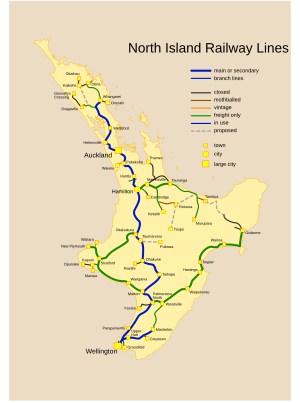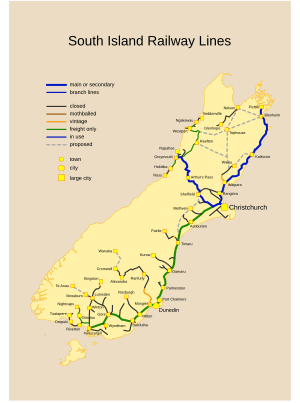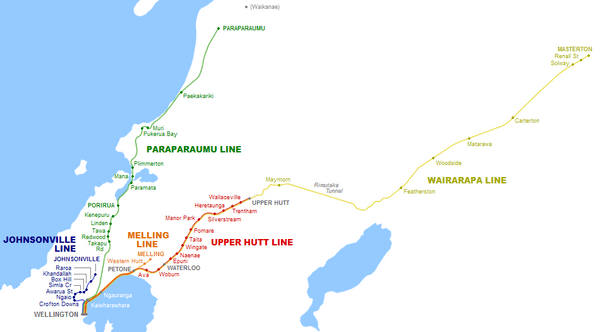List of railway lines in New Zealand facts for kids
The railway network in New Zealand helps connect towns and cities across the country. It has four main lines, six secondary lines, and many smaller branch lines. These railways link almost all major cities, except for a few like Nelson and Queenstown.
KiwiRail owns and manages most of the railway network today. Building these railways started way back in 1863. At first, local governments built them, then the main government took over. Over the years, the railway system changed hands a few times. In 1981, it became a company called the New Zealand Railways Corporation. Then, in 1993, it was sold to a private company called Tranz Rail. But in 2003, the government bought the network back!
Today, KiwiRail runs all the freight trains that carry goods. They also run a few passenger trains, mostly for tourists, on special routes. In Auckland, Auckland One Rail operates the "AT Metro" suburban trains. In Wellington, Transdev runs the Metlink passenger trains. And in Dunedin, Dunedin Railways (which used to be called Taieri Gorge Railway) runs fun tourist trains.
Contents
- New Zealand's National Rail Network
- Main Trunk Lines: Connecting Major Cities
- Secondary Main Lines: Important Regional Routes
- Branch Lines: Local Connections
- Private Railway Lines
- Planned Railways That Were Never Built
- Nelson – Blenheim "Notional Railway"
- Bush Tramways: Moving Timber and Minerals
- Street Tramways: City Travel
- Heritage and Private Railways: Keeping History Alive
New Zealand's National Rail Network
The lines shown in bold are currently used by KiwiRail.
Main Trunk Lines: Connecting Major Cities
These are the most important railway lines that connect big cities across New Zealand.
| Name | Route | Length | What it's used for |
|---|---|---|---|
| North Island Main Trunk | Wellington – Auckland | 681 km (423 mi) | Carrying goods & passengers |
| East Coast Main Trunk | Hamilton – Tauranga – Kawerau | Carrying goods only | |
| Midland Line | Rolleston – Greymouth | 212 km (131 mi) | Carrying goods & passengers |
| Main North Line | Christchurch – Picton | 348 km (216 mi) | Carrying goods & passengers |
| Main South Line | Lyttelton – Invercargill | 601 km (373 mi) | Carrying goods & passengers (Christchurch – Rolleston) Carrying goods only (Lyttelton – Christchurch, Rolleston – Invercargill) |
The last two lines are sometimes called the South Island Main Trunk Railway.
Secondary Main Lines: Important Regional Routes
These lines are also very important and connect different regions.
| Name | Route | Length | What it's used for |
|---|---|---|---|
| Marton - New Plymouth Line | Marton – New Plymouth | 212 km (132 mi) | Carrying goods only |
| North Auckland Line | Westfield Junction – Otiria | 281 km (175 mi) | Carrying goods and passengers (south of Swanson) Carrying goods only (Swanson to Otiria) |
| Palmerston North–Gisborne Line | Palmerston North – Gisborne | 390 km (240 mi) | Carrying goods & passengers (for charters/cruises). Part of the line (Napier to Muriwai) was closed in 2012. |
| Stillwater–Ngakawau Line | Stillwater – Ngakawau | 136 km (85 mi) | Carrying goods only |
| Stratford–Okahukura Line | Stratford – Okahukura | 144 km (89 mi) | Passengers (leased to a private company since 2012). |
| Wairarapa Line | Wellington – Woodville | 176 km (109 mi) | Carrying goods & passengers (Wellington to Masterton) Carrying goods only (Masterton to Woodville) |
Branch Lines: Local Connections
Branch lines are smaller railway lines that connect to the main or secondary lines, often serving specific towns or industries.
Auckland Branch Lines
| Name | Route | What it's used for |
|---|---|---|
| Newmarket Line | Quay Park junction – Newmarket | Carrying goods & passengers |
| Southdown Branch | Westfield Junction – Southdown Freight Centre | Carrying goods only |
| Mission Bush Branch | Paerata – Glenbrook – Mission Bush | Carrying goods only |
| Onehunga Branch | Penrose – Onehunga | Carrying passengers |
| Manukau Branch | Wiri – Manukau | Carrying passengers |
| Waiuku Branch | Glenbrook – Waiuku | Closed in 1967 Now used by the Glenbrook Vintage Railway |
Auckland Suburban Passenger Lines
These lines are used by people travelling around Auckland every day.
| Name | Route |
|---|---|
| Eastern Line | Britomart Transport Centre – Manukau |
| Southern Line | Britomart Transport Centre – Pukekohe |
| Western Line | Britomart Transport Centre – Swanson |
| Onehunga Line | Newmarket – Onehunga |
Waikato / Coromandel Branch Lines
| Name | Route | What it's used for |
|---|---|---|
| Cambridge Branch | Ruakura – Cambridge | Carrying goods only. Part of it closed in 1999. |
| Rotowaro Branch | Carrying coal only | |
| Thames Branch/Waitoa Branch | Morrinsville – Thames | Part of it was closed in 1991. The Morrinsville to Waitoa section reopened in 2004 for goods. |
Bay of Plenty Branch Lines
| Name | Route | What it's used for |
|---|---|---|
| Kinleith Branch | Waharoa – Kinleith Mill | Carrying goods only |
| Mount Maunganui Branch | Carrying goods only | |
| Murupara Branch | Carrying goods only | |
| Rotorua Branch | Putāruru – Rotorua | Leased to a private company since 2010. |
Gisborne – Hawke's Bay Branch Lines
| Name | Route | What it's used for |
|---|---|---|
| Napier Port Branch/Ahuriri Branch | Carrying goods only |
Taranaki Branch Lines
| Name | Route | What it's used for |
|---|---|---|
| Castlecliff Branch | Whanganui – Castlecliff | Carrying goods only. |
| Opunake Branch/Kapuni Branch | Eltham – Kapuni – Opunake | Carrying goods only. Part of it is closed. |
| Waitara Branch | Lepperton – Waitara | Closed in 1999. Leased to a private company, the Waitara Railway Preservation Society. |
| Whanganui Branch | Aramoho – Whanganui | Carrying goods only |
Wellington Branch Lines
| Name | Route | What it's used for |
|---|---|---|
| Gracefield Branch | Woburn – Gracefield | Carrying goods only. Part of it was closed in 2002. |
| Johnsonville Line | Wellington – Johnsonville | Carrying passengers only. This used to be part of the North Island Main Trunk Line. |
| Melling Branch | Petone – Melling | Carrying passengers only. This used to be part of the Wairarapa Line. |
Wellington Suburban Rail Lines
These lines are used by people travelling around Wellington every day.
| Name | Route |
|---|---|
| Johnsonville Line | Wellington – Johnsonville |
| Kapiti Line | Wellington – Waikanae |
| Hutt Valley Line | Wellington – Upper Hutt |
| Melling Line | Wellington – Melling |
| Wairarapa Line | Wellington – Masterton |
West Coast Branch Lines
| Name | Route | What it's used for |
|---|---|---|
| Hokitika Branch/Ross Branch | Greymouth – Ross | Carrying goods only. Part of it closed in 1980. |
| Ngakawau Branch/Seddonville Branch | Westport – Mokihinui Mine | Carrying goods only. Parts of it closed in 1974 and 1981. |
| Rapahoe Branch | Greymouth – Rapahoe | Carrying goods only |
Canterbury Branch Lines
| Name | Route | What it's used for |
|---|---|---|
| Fairlie Branch | Washdyke – Eversley | Closed in 1968. A section is now operated by the Pleasant Point Museum and Railway. |
| Ferrymead Branch | Christchurch – Ferrymead | Closed in 1868. Now the Ferrymead Railway. |
| Little River Branch | Lincoln – Little River | Closed in 1962. Now the Little River Rail Trail. |
| Mount Somers Branch/Springburn Branch | Tinwald – Springburn | Parts closed in 1957 and 1968. A section is operated by Plains Vintage Railway. |
| Waiau Branch | Waipara – Waiau | Closed in 1978. A section is operated by Weka Pass Railway. |
Otago Branch Lines
| Name | Route | What it's used for |
|---|---|---|
| Catlins River Branch | Balclutha – Tahakopa | Carrying goods only. Part of it closed in 1971. |
| Kingston Branch | Kingston – Fairlight | Carrying passengers only, by Kingston Flyer Ltd. |
| Otago Central Railway | Wingatui – Cromwell | Carrying passengers only beyond Taieri. Parts closed in 1980 and 1990. The Taieri to Middlemarch section is operated by Dunedin Railways. The Middlemarch to Clyde section is now the Otago Central Rail Trail. |
| Port Chalmers Branch | Sawyers Bay – Port Chalmers | Carrying goods only |
Southland Branch Lines
| Name | Route | What it's used for |
|---|---|---|
| Bluff Branch | Invercargill – Bluff | Carrying goods only. |
| Wairio Branch/Ohai Industrial Line | Invercargill – Ohai | Carrying goods only. Part of it is currently closed. |
Private Railway Lines
Some railway lines in New Zealand were built by private companies, not the government. Most of these companies didn't last long, and the government eventually bought their lines.
One of the most successful private railways was the Wellington and Manawatu Railway. It ran between Wellington and Longburn from 1885 to 1908. Another well-known one was the New Zealand Midland Railway Company, which built parts of the Midland, Nelson, and West Coast lines.
Some examples of private lines include:
- Castlecliff Railway
- Ohai Railway Board
- Sanson Tramway
- Wellington and Manawatu Railway Company Limited
Planned Railways That Were Never Built
Many railway lines were planned, especially in the 1800s, but they were never actually built. Sometimes, they even started building the path for the tracks!
Some important planned lines included:
- Auckland Airport Line: A plan to extend the railway to Auckland Airport.
- Auckland City Rail Link: An underground railway link in central Auckland. This is now being built!
- Cromwell – Queenstown: A proposed connection for tourist trains.
- Nelson – Blenheim line: A line to connect Nelson to the rest of the South Island network.
Nelson – Blenheim "Notional Railway"
In 1957, a special rule was made for the area between Nelson and Blenheim. Even though there was no railway line there, the government pretended there was! This was to help people in Nelson, as their local railway had closed in 1955. People and goods travelled by road, but the government paid the difference so they would pay the cheaper railway prices instead of the more expensive road prices. This "notional railway" helped people save money for 22 years.
Bush Tramways: Moving Timber and Minerals
Bush tramways were special railway lines built to carry heavy things like timber (wood) or minerals from mines. They were often in remote areas. These lines were usually built lighter than regular railways, with steeper hills and sharper turns. Trains on these lines went slower, and sometimes even road vehicles were changed to run on the tracks! As trucks and other road vehicles got better, these bush tramways slowly disappeared.
A famous example was the Taupo Totara Timber Company's line, which ran between Putaruru and Mokai. Another was the Dun Mountain Railway, which carried minerals.
Street Tramways: City Travel
Big networks of street tramways used to operate in cities like Auckland, Wellington, Christchurch, and Dunedin. Smaller ones were in other towns too. These trams were pulled by horses, steam engines, or electricity. Most of them stopped running in the 1950s because buses became more popular.
However, trams have made a comeback in some cities as tourist attractions! Christchurch restarted its tram service in 1995, Auckland in 2011, and Wanganui in 2013. You can learn more at Trams in New Zealand.
Heritage and Private Railways: Keeping History Alive
There are many groups in New Zealand that run old railway lines and museums. Most of these are run by volunteers who love trains and want to keep history alive. They let people ride on old trains and learn about how railways used to work. Dunedin Railways is one of the few that also employs paid staff.





